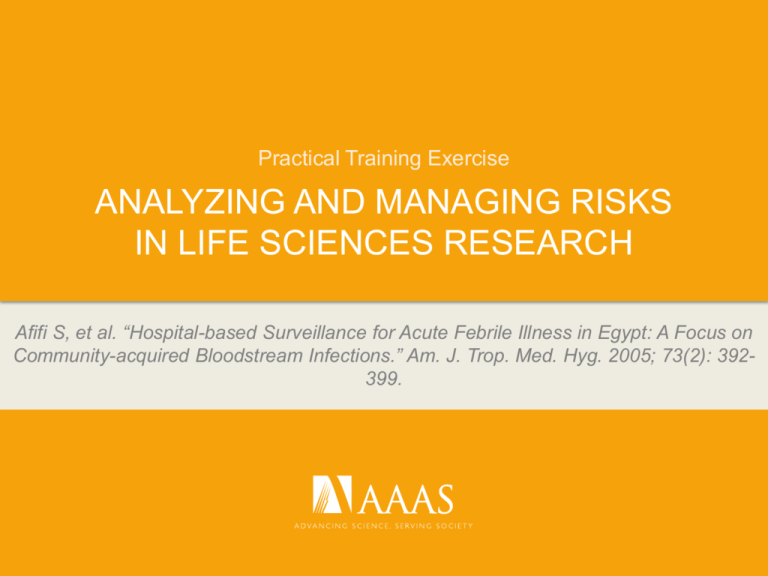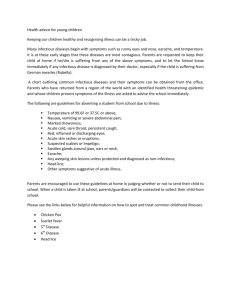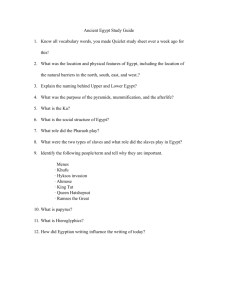Case Study
advertisement

Practical Training Exercise ANALYZING AND MANAGING RISKS IN LIFE SCIENCES RESEARCH Afifi S, et al. “Hospital-based Surveillance for Acute Febrile Illness in Egypt: A Focus on Community-acquired Bloodstream Infections.” Am. J. Trop. Med. Hyg. 2005; 73(2): 392399. This exercise was developed by Center for Science, Technology and Security Policy at the American Association for the Advancement of Science (AAAS). This work is licensed by AAAS under a Creative Commons AttributionNonCommercial-ShareAlike 3.0 United States License. You may contact the copyright holder at: 1200 New York Ave. Washington, DC 20002 cstspinfo@aaas.org 1-202-326-6493 This series of case study exercises was developed with input from: Lindsey Marburger, Nisreen AlHmoud, Oussama ben Fradj, Eleanor Celeste, Gwenaële Coat, Cristine Geers, Irene Jillson, Abdulaziz Kaed, Rawan Khasawneh, Fadia Maki, Kimberly Schaub, and Kavita Berger. Developed with the support of the U.S. Department of State’s Biosecurity Engagement Program. 2 Learning Objectives 1 2 3 Develop the skills to think critically about risks and risk mitigation strategies needed in your own scientific environment; Enhance your ability to identify risk management strategies and approaches that minimize identified risks and maintain the high-quality and utility of the scientific activity; and Apply the risk analysis framework to your own or your peers’ scientific activities. 3 Participant Expectations By the end of this exercise, you will have familiarity with: 1. The definitions of different types of risks associated with laboratory, field, and public health research. 2. The process of risk analysis—risk identification, assessment, management, and communication—including: – How to identify and assess risks by considering the possible likelihood and consequences of risks, and the risks versus benefits of a research activity, – Strategies for managing risks, and – Who, when, and how to communicate risks. 3. How to apply the risk analysis framework to your own scientific activities. 4 Ground Rules for Participation 1 2 3 4 5 Prior to starting this exercise, participants should have read the case study article. Ask the facilitator to clarify questions about the case study article. Focus on understanding and analyzing the diverse risks involved in the research rather than on critiquing the methodologies or research choices of the authors. Interact with one another in a way that encourages open communication and exchange of ideas. For example, listen to everyone’s ideas respectfully. You may want to take your own notes to enhance your ability to actively participate in the training activity. 5 Biorisk Glossary These definitions are from the WHO’s Responsible Life Science for Global Health Security: A Guidance Document. • • • • • • • Bioethics Biorisk Biorisk reduction Laboratory biosafety Laboratory biosecurity Dual-use life sciences research Research excellence Additional concepts: • Protection of human subjects • Protection of animal subjects • Responsible research/responsible conduct of research 6 Risk Analysis Framework Your risk review will follow these 4 Stages: 1 Risk Identification 2 Risk Assessment 3 Risk Management 4 Risk Communication 7 1. Risk Identification 2. Risk Assessment Process by which researchers consider all possible internal, external, and organizational risks. Process by which researchers identify needed resources and consider biosafety/biosecurity recommendations. • Also defined as the “process of evaluating the risk(s) arising from a hazard(s), taking into account the adequacy of any existing controls and deciding whether or not the risk(s) is acceptable).” (OHSAS 18001: 2007) Asks the question: What are the possible risks associated with the research? Asks the questions: How likely are the risks to occur? What are the potential consequences if the risks occur? Do the risks outweigh the benefits? 8 3. Risk Management 4. Risk Communication Process by which researchers consider regulations/guidelines, training, and SOP compliance issues. Process by which researchers consider communication strategies, non-compliance issues and approval/modification processes. • Asks the question: What risk management strategies could minimize the likelihood that the risk will occur or the consequences if the risks occurred? • Possible strategies: physical barriers, personnel training or vetting, regulations and laws, and/or alternative experiments Asks the questions: What risks should be communicated with ethics or other research review committees prior to project initiation? What risks should be communicated to research participants or fellow researchers during the research project? What risks, if any, might come from sharing research data or results? What strategies could be used to minimize the risks? 9 Risk Analysis Chart 10 CASE STUDY Hospital-based Surveillance for Acute Febrile Illness in Egypt: A Focus on Community-acquired Bloodstream Infections . Afifi S, et al. “Hospital-based Surveillance for Acute Febrile Illness in Egypt: A Focus on Community-acquired Bloodstream Infections.” Am. J. Trop. Med. Hyg. 2005; 73(2): 392-399. Outline of Case Study Part 1: Research Question/Hypothesis Part 2: Background Information Overview Part 3: Research Methodology Part 4: Risk Analysis in the Research Article Part 5: Research Results and Conclusions 12 Research Question/Hypothesis Research Statement Laboratory confirmation of the cause of acute febrile illness could take days to weeks limiting the ability of public health workers to prevent or treat the disease. The need for better tools to identify the cause of acute febrile illness in Egypt (including Salmonella enterica typhi and brucella) prompted the Ministry of Health to develop national diagnostic laboratory capacitybuilding initiatives. The authors proposed to assess the laboratory-based acute febrile illness surveillance during the first four years of implementation of these capacity-building initiatives. Surveillance Sites in Egypt Figure: Afifi S, et al., 2005. 13 Background Information Overview Causes of Acute Febrile Illness • Acute Febrile Illness refers to the sudden onset of illness that is accompanied by a high fever. • Acute febrile illness can be caused by bacterial and viral infection. • In Egypt, brucellosis and typhoid fever cause the majority of acute febrile illness. • An estimated 7% of acute febrile illness is caused by brucella. • Brucellosis most often occurs from close contact with animal species (zoonosis). Brucellosis Photo Credit: Dennis Kunkel Microscopy, Inc. Salmonella Typhi Photo Credit: Dr. Volker Brinkmann 14 Background Information Overview Identification of Typhoid Fever and Brucellosis in Egypt • • Clinical diagnosis (syndromic surveillance) Sentinal surveillance through laboratory tests – Culturing the bacteria from blood samples – Performing antibody tests using ELISA – Performing serology tests using: Widal test, Brucella agglutination assay, Rose Bengal tests, lateral flow immunochromatography Figure Credit: Crump J.A. et al, 2003. 15 Background Information Overview Efforts to Strengthen Infectious Disease Surveillance in Egypt In 1998 • The Egyptian Ministry of Health and Population (MOHP) and U.S. Naval Medical Research Unit 3 (NAMRU-3) began efforts to improve epidemiology and laboratory capacity of infectious diseases • The U.S. Global Emerging Infections Surveillance & Response System (GEIS) joined NAMRU-3 in 1997 • The MOHP initiated health sector reform in Egypt with support from USAID 16 Research Methodology • Patient Inclusion: Participants were recruited from hospitals participating in the 4year study. Participants were selected based on their age, duration of fever, and the World Health Organization case definitions for brucellosis and typhoid fever. Participants provided at least one blood sample at admission to the hospital. • Epidemiologic Data Collection: Participants were asked to provide demographic, occupational, and clinical information; risk factors; drinking water sources; consumption of dairy products; and contact with animals. • Laboratory Tests: Participant blood was collected prior to initiating treatment. The blood was used to inoculate blood culture media or allowed to clot for collection of serum. Positive blood cultures were tested using standard microbiology techniques. – – – • • The presence of typhoid fever was examined using basic serology tests and the Widal tests. The presence of Brucella was identified using serological tests. Antibiotic sensitivity tests were performed to study antibiotic resistance of the bacteria. Disease diagnosis: Diagnosis was based on clinical diagnosis and laboratory confirmed tests. Data analysis: The data was analyzed using standard statistical analysis. 17 Risk Analysis in this Research Article While risk analysis is an important part of science, few scientific publications include in-depth descriptions of how the authors assessed and managed risk. Today your task is to perform a risk analysis based on this research article. To begin, answer the following question: Based on your current knowledge of the experimental procedures or research purpose, what risks might be important to consider in designing, carrying out, or communicating this research? 18 Risk Identification Hospital-based Surveillance for Acute Febrile Illness in Egypt: A Focus on Community-acquired Bloodstream Infections Questions What, if any, are the potential risks to researcher and staff during collection, handling, transportation, and laboratory analysis of infected human blood samples? What, if any, are additional or different risks to the health care providers who clinically evaluate and treat infected patients? What, if any, are the potential risks of accidental release or exposure might affect the human, animal, or environmental health of the neighboring community? Could the research used to deliberately cause harm, through deliberate release of Salmonella enterica typhi or Brucella? What, if any, are the possible risks to the patients who participate in this study? 19 Risk Assessment Hospital-based Surveillance for Acute Febrile Illness in Egypt: A Focus on Community-acquired Bloodstream Infections Question To what extent does this research pose a public health, animal health, or environmental threat? What methodological steps in sample collection, transport, and analysis are most likely to result in a biosafety accident or incident? What methodological steps in sample collection, transport, and analysis are most likely to result in a biosecurity accident or incident? What are the resources, expertise, training, and tools that could be useful in assessing the risks identified for this research project? 20 Risk Management Hospital-based Surveillance for Acute Febrile Illness in Egypt: A Focus on Community-acquired Bloodstream Infections Question What international, national, or institutional laws, regulations, policies, or best practices could help mitigate the risks from this research project? What standard operating procedures (SOPs) in sample collection, storage, transport, and analysis should be employed in this research project to mitigate any safety or security risks? What approaches could be taken to reduce the safety and security risks of the research project? What, if any, specialized competencies, skills, and training are needed to successfully carry out this experiment, including identifying and taking samples from patients, transporting whole blood samples, and analyzing samples in the laboratory? What approaches could be used to address the ethical considerations associated with the research project? 21 Research Results and Conclusions Results • • • • • Typhoid fever and brucellosis are “the most common bacterial causes of AFI [acute febrile illness] in Egypt. Typhoid fever is a more common cause of acute febrile illness in Upper Egypt. Approximately 5.6% isolates of Salmonella enterica typhi obtained and cultured from participant samples had multi-drug resistance three antibiotics. Multi-drug resistant strains of Salmonella enterica typhi appear to be confined to specific geographic regions. Brucellosis affects individuals throughout Egypt. Brucellosis is most common in the spring and summer, which coincides with animal breeding season. “Between 1998 and 2003, 5% of culture positive for Salmonella enterica serogroup Typhi, 3% for Brucella, and 2% for other pathogens. An additional 18% of patients had positive serologic results for typhoid and 11% for burcellosis.” Conclusions Laboratory testing is critical to distinguishing the cause of acute febrile illness. The laboratory capacity-building efforts of the Egyptian MOHP have “enabled clinicians to tailor therapy to specific pathogens.” Risk factors: – Clean water is most significant for typhoid fever – Proximity to infected animals and ingestion of raw dairy products are most significant for brucellosis 22 Risk Communication Hospital-based Surveillance for Acute Febrile Illness in Egypt: A Focus on Community-acquired Bloodstream Infections Question What are the risks that should be communicated during this research? To whom? How should researchers communicate the purpose and participant involvement to hospital patients experiencing acute high fever? What social and cultural sensitivities should be considered when discussing the research project and results with other scientists, human and animal health officials, clinicians, and policymakers or the public? How might the researcher communicate the results while limiting the transfer of sensitive and identifying information? What types of data anonymizing and data security needs to be done to protect collected epidemiological data? How can researchers best communicate research results with research participants and relevant stakeholders? Do researchers have an obligation to provide results to any particular individuals, ministries, or organizations? 23 Final Exercise: Risk in Your Own Research Perform a risk analysis of your own research. Choose one past, ongoing, or future research project to analyze: 1. Identification: What are the primary risks you face in your research? Think about the risks to you and other researchers and technicians in the field, clinic, and/or lab, the general public, the environment and economy, your institution, and human and animal subjects. 2. Assessment: What are the consequences of the identified risks if they occur? Based on your assessment of consequence and probability, are there are there any risks that could harm people, animals, crops, or the economy? What resources, capabilities, and skills are needed to mitigate these risks? 3. Management: What strategies could you use or resources you could refer to minimize or mitigate these risks? (These strategies should not decrease the quality of the research.) For ideas of possible strategies and resources, consider those discussed in this practical exercise and from your own experiences. Are there any risks associated with your research that cannot be adequately mitigated? 4. Communication: What risks, if any, are associated with communicating your research during the design or conduct of the research? What risks, if any, are associated with communicating the research results at scientific conferences and in publications during the conduct and after completion of the project? What strategies could you use to mitigate the risks? Are there any stakeholders with whom you must share the risks of your research? Your findings? 24 Example Risk Analysis Strategy Communicate “Laboratory risk management.” CWA 15793: 2011 25 Reference List Background Information Afifi S, et al. “Hospital-based Surveillance for Acute Febrile Illness in Egypt: A Focus on Community-acquired Bloodstream Infections.” Am. J. Trop. Med. Hyg. 2005; 73(2): 392-399. Crump J.A. et al. Estimating the Incidence of Typhoid Fever and Other Febrile Illnesses in Developing Countries. Emerg Infect Dis. 2003 May; 9(5); 539-544. Gaumer G and Rafeh N. Strengthening Egypt’s Health Sector Reform Program: Pilot Activities in Suez. 2005 Oct. Available at: www.abtassociates.com/reports/egypt_health_reform_suex_1005.pdf Jennings GJ, Hajjeh RA, Girgis FY, Fadeel MA, Maksoud MA, Wasfy MO, El-Sayed N, Srikantiah P, Luby SP, Earhart K, Mahoney FJ. Brucellosis as a cause of acute febrile illness in Egypt. Trans R Soc Trop Med Hyg. 2007 Jul;101(7):707-13. National Research Council. Perspectives on the Department of Defense Global Emerging Infections and Reporting System: A Program Review. (2001). National Academy Press (Washington, DC), p. 83. World Health Organization, Responsible Life Science for Global Health Security: A Guidance Document. 2010; Available at: http://whqlibdoc.who.int/hq/2010/WHO_HSE_GAR_BDP_2010.2_eng.pdf. Diagrams and Images Crump J.A. et al. Estimating the Incidence of Typhoid Fever and Other Febrile Illnesses in Developing Countries. Emerg Infect Dis. 2003 May; 9(5); 539-544. Dennis Kunkel Microscopy, Inc. Brucella Species. Available at: http://quizlet.com/13134037/microbiology-exam-3-flash-cards/ . European Committee for Standardization (CEN). CEN Workshop Agreement: CWA 15793. “Laboratory biorisk management.” Ref. No: CWA 15793:2011 D/E/F. September 2011: 17. Available at: ftp://ftp.cenorm.be/CEN/Sectors/TCandWorkshops/Workshops/CWA15793_September2011.pdf. Dr. Volker Brinkmann, MPI for Infection Biology. “Salmonella Typhi.“ Available at: http://www.sciencedaily.com/releases/2006/11/061128092129.htm and www.Phys.org. 26






